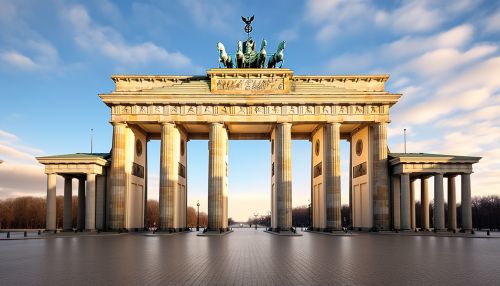Brandenburg Gate
History
The Brandenburg Gate is one of the most iconic landmarks in Germany, with a rich history that spans over two centuries. The gate was commissioned by Friedrich Wilhelm II, King of Prussia, to represent peace. The construction started in 1788 and was completed in 1791. The design of the gate was inspired by the Propylaea, the gateway to the Acropolis in Athens, Greece.


The gate has played a significant role in major historical events. During the Napoleonic wars, the Quadriga, a chariot drawn by four horses atop the gate, was taken to Paris by Napoleon as a war trophy. It was returned to Berlin after Napoleon's defeat in 1814. In the 20th century, the gate became a symbol of division during the Cold War, as it was located right at the border of East and West Berlin. After the fall of the Berlin Wall in 1989, the gate was reopened, symbolizing the reunification of Germany.
Architecture
The Brandenburg Gate stands at 26 meters high, 65.5 meters wide, and 11 meters deep. It consists of twelve Doric columns, six on each side, forming five passageways. The columns are 1.75 meters in diameter and 15 meters high. The gate is built in the neoclassical style, with influences from the Greek Revival movement.
The most distinctive feature of the gate is the Quadriga, a sculpture of a chariot drawn by four horses, driven by Victoria, the Roman goddess of victory. The Quadriga faces east, towards the city center. The gate is adorned with various reliefs and sculptures, most of which depict scenes from Greek mythology.
Significance
The Brandenburg Gate is more than just an architectural marvel. It is a symbol of German history and unity. It has witnessed the rise and fall of empires, the horrors of war, and the joy of peace and reunification. Today, it stands as a reminder of the turbulent history of Germany and a symbol of hope for a peaceful future.
The gate has been the site of numerous important events and speeches. One of the most famous was President Ronald Reagan's 1987 speech, where he famously implored, "Mr. Gorbachev, tear down this wall!" The gate was also the backdrop for the celebrations marking the reunification of Germany in 1990.
In Popular Culture
The Brandenburg Gate has been featured in numerous films, television shows, and works of literature. It is often used as a symbol of Germany in popular culture. The gate has also been depicted on German euro coins and is a popular tourist attraction.
